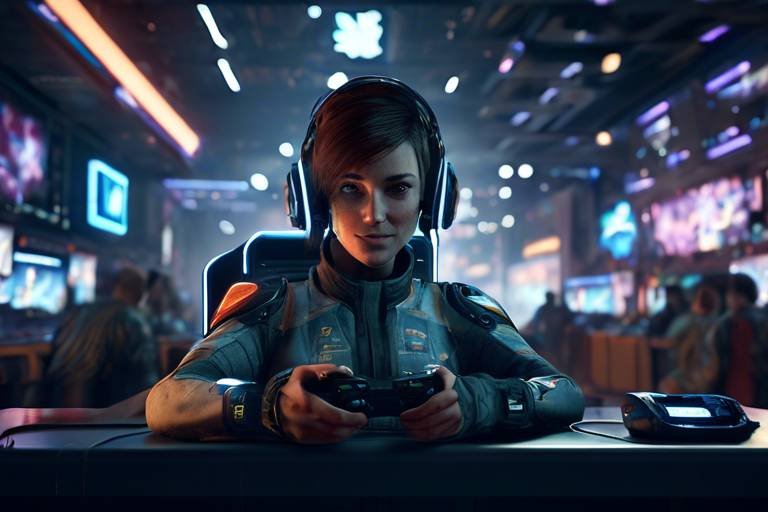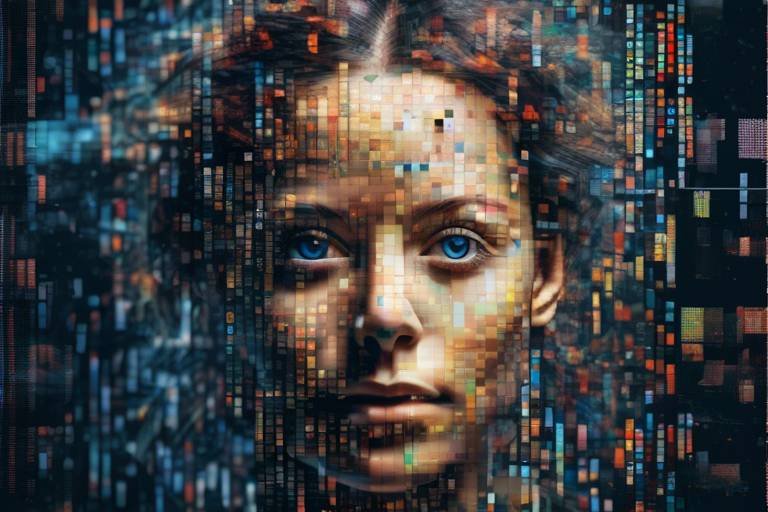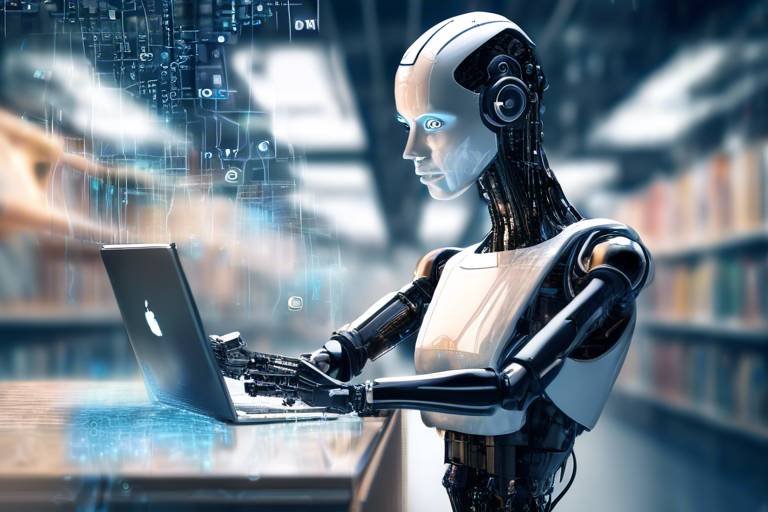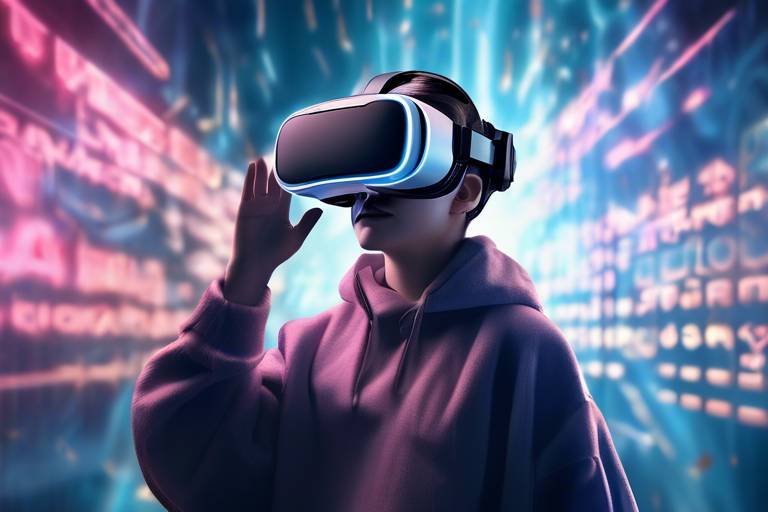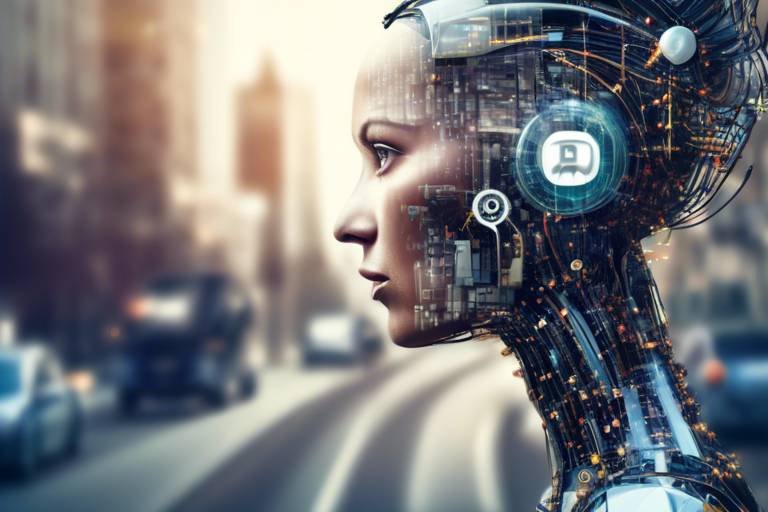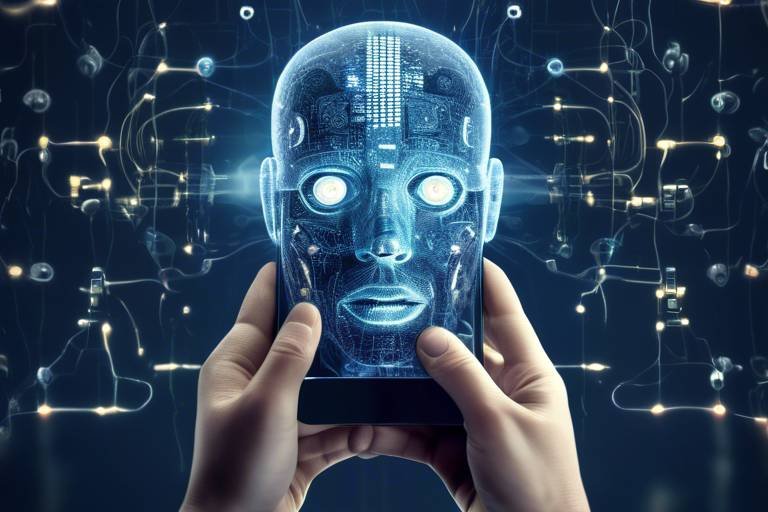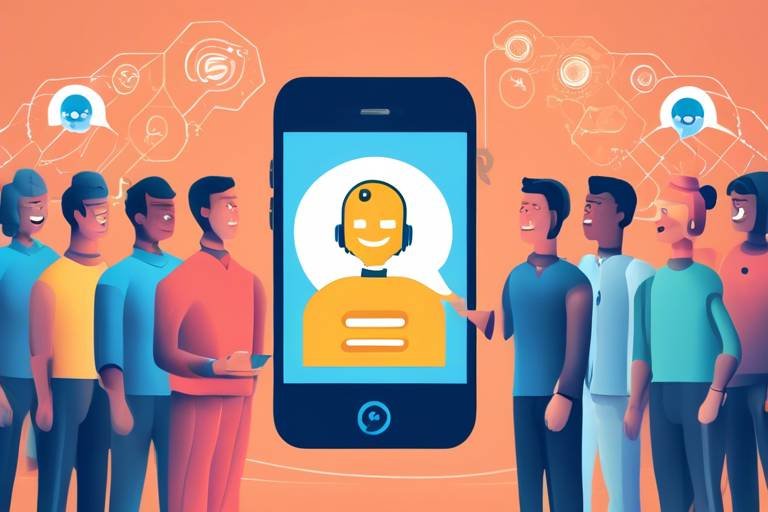AI in Gaming: The Future Looks Bright
In recent years, the gaming industry has witnessed a remarkable transformation, largely driven by advancements in artificial intelligence (AI). As we stand on the brink of a new era, it’s clear that AI is not just a trend; it’s a fundamental shift that is reshaping how games are developed and played. From enhancing player experiences to streamlining game development processes, the role of AI in gaming is becoming increasingly pivotal. Imagine a world where non-player characters (NPCs) learn and adapt to your gameplay style, making every session unique and engaging. This is not just a dream; it’s the reality of modern gaming, and the future looks incredibly bright.
The journey of AI in gaming is fascinating and filled with innovation. It all began with simple algorithms that dictated basic behaviors of characters in games. Early examples included Pac-Man and Space Invaders, where the AI was limited to predefined patterns. Fast forward to today, and we see AI systems that can analyze player behavior in real time, creating a more immersive experience. This evolution has been driven by advancements in machine learning, neural networks, and data analytics, allowing developers to create complex systems that enhance gameplay and player engagement.
Today, AI is utilized in various ways within the gaming industry. From crafting intelligent NPCs to generating entire game worlds, AI technologies are revolutionizing the landscape. Here are some key areas where AI is making a significant impact:
- NPC Behavior: AI-driven NPCs can react to player actions in real time, providing a richer gaming experience.
- Procedural Content Generation: AI algorithms create unique levels and environments, ensuring that players have endless exploration opportunities.
- Personalized Gaming Experiences: AI tailors gameplay to individual players, enhancing engagement and satisfaction.
One of the most exciting developments in AI technology is the enhancement of non-player characters. Gone are the days of predictable NPCs that follow rigid scripts. With AI, these characters can now engage in more realistic and responsive interactions. Imagine a game where NPCs remember your past actions, adjusting their behavior based on your choices. This level of interactivity not only enriches the gaming experience but also immerses players in the story like never before.
AI enables NPCs to learn from player behavior, creating a dynamic environment that challenges players. For example, if a player consistently uses a particular strategy, the NPCs can adapt their tactics to counter this approach, resulting in a more engaging and unpredictable gameplay experience. This adaptability keeps players on their toes, making each session feel fresh and exciting.
Advancements in AI-driven dialogue systems have revolutionized how players interact with NPCs. Instead of scripted responses, AI allows for natural conversations that can change based on the context of the game. This not only enhances storytelling but also deepens player immersion. Players can now feel like they are part of a living, breathing world where their choices truly matter.
Another groundbreaking application of AI in gaming is procedural content generation. AI algorithms can create vast, unique game worlds and levels on the fly. This means that players can enjoy endless exploration opportunities, as no two gaming experiences are the same. The result? A game that feels alive and continuously evolving, providing players with varied gameplay experiences that keep them coming back for more.
Despite the exciting advancements, integrating AI into gaming is not without its challenges. Developers face several hurdles, including ethical considerations and technical limitations. It’s essential to strike a balance between leveraging AI capabilities and maintaining the core essence of human creativity in game design.
As AI becomes more prevalent in gaming, ethical implications arise. Issues such as data privacy, the impact on employment, and the potential for bias in AI algorithms must be carefully considered. Developers need to prioritize responsible AI development to ensure that the gaming industry remains a safe and inclusive space for all.
Implementing AI also comes with technical challenges. Developers must navigate computational demands, algorithm biases, and the need for continuous updates to keep games relevant. These challenges require a commitment to innovation and adaptability in a rapidly evolving technological landscape.
Looking ahead, the future of AI in gaming is filled with potential. As technology continues to advance, we can expect even more sophisticated AI systems that enhance player experiences. Imagine games that can dynamically adjust difficulty levels based on player skill or AI that can generate entirely new narratives based on player choices. The possibilities are endless, and the next generation of gaming experiences promises to be more immersive and engaging than ever before.
- How is AI changing the way games are developed?
AI streamlines the development process by automating tasks like level design and NPC behavior, allowing developers to focus on creativity and storytelling.
- Will AI replace human game designers?
No, AI is a tool that enhances creativity, but the human touch in storytelling and design is irreplaceable.
- What are some examples of AI in popular games?
Games like The Last of Us Part II and Red Dead Redemption 2 utilize advanced AI for realistic NPC interactions and dynamic environments.

The Evolution of AI in Gaming
The journey of artificial intelligence (AI) in gaming is nothing short of fascinating. It’s a tale that begins in the early days of video games when AI was merely a collection of simple algorithms, often resulting in predictable and repetitive behaviors. Remember those classic arcade games? The enemies would follow a set path, and once you learned their movements, you could easily outsmart them. Fast forward a few decades, and we find ourselves in a world where AI not only enhances gameplay but also transforms the very essence of player engagement.
Initially, AI was primarily used to control non-player characters (NPCs). These characters were programmed with basic logic that dictated their actions. However, as technology advanced, so did the complexity of AI systems. Developers began to explore more sophisticated algorithms that could analyze player behavior and adapt accordingly. This evolution paved the way for a more immersive gaming experience, where NPCs could react to players in real-time, making decisions based on a variety of factors.
One of the most significant milestones in the evolution of AI in gaming was the introduction of machine learning. This technology allowed AI to learn from vast amounts of data, improving its decision-making capabilities. As a result, NPCs became more lifelike, exhibiting behaviors that felt organic rather than scripted. Players could no longer predict their actions, which added an exciting layer of challenge and realism to games.
Moreover, the rise of procedural content generation marked another turning point. This technique uses AI algorithms to create expansive game worlds and levels dynamically. Instead of developers painstakingly designing every inch of a game, AI can now generate unique landscapes, quests, and challenges tailored to individual players. Imagine exploring an infinite universe where every planet offers a distinct adventure, all thanks to AI!
The evolution of AI in gaming can be summarized in the following stages:
| Era | Key Developments |
|---|---|
| 1970s-1980s | Basic algorithms for NPC behavior; predictable patterns. |
| 1990s | Introduction of more complex AI systems; NPCs begin to exhibit adaptive behaviors. |
| 2000s | Machine learning techniques emerge; NPCs become more realistic and unpredictable. |
| 2010s-Present | Procedural content generation revolutionizes game design; vast, unique worlds created by AI. |
As we look to the future, it’s clear that AI will continue to play a pivotal role in shaping the gaming landscape. The potential for even more advanced AI systems is immense, promising richer narratives, deeper player interactions, and an overall gaming experience that is more engaging than ever before. The evolution of AI in gaming is not just a technological advancement; it’s a revolution that redefines how we play and interact with digital worlds.
- How has AI changed the way we play games? AI has made games more immersive by creating responsive NPCs and dynamic game worlds that adapt to player actions.
- What are the ethical concerns surrounding AI in gaming? Issues include data privacy, job displacement in the industry, and the need for responsible AI usage.
- Will AI replace human creativity in game design? While AI can enhance design processes, it is unlikely to replace the unique creativity that human developers bring to gaming.

Current Applications of AI in Gaming
Artificial Intelligence (AI) has become an integral part of the gaming industry, revolutionizing how games are developed and played. From enhancing player interactions to creating immersive environments, AI is reshaping the gaming landscape in ways we could only dream of a decade ago. One of the most exciting aspects is how AI is utilized to create non-player character (NPC) behavior that feels lifelike and responsive. Imagine walking through a game world where NPCs react to your actions in real-time, making the environment feel alive and engaging. This level of immersion is achieved through sophisticated algorithms that analyze player behavior and adapt accordingly.
Additionally, AI plays a crucial role in procedural content generation, which allows developers to create vast and unique game worlds. This means that instead of manually designing every aspect of a game, AI can generate levels, landscapes, and even quests dynamically. Players are presented with a virtually endless array of exploration opportunities, ensuring that no two gaming experiences are ever the same. The thrill of discovering new terrains and challenges is amplified by the unpredictability that AI brings to the table.
Moreover, AI is paving the way for personalized gaming experiences. By analyzing player data, AI systems can tailor content to individual preferences, ensuring that each player encounters challenges and stories that resonate with them. For example, if you tend to favor stealth gameplay, AI can adjust the game’s difficulty and scenarios to enhance that experience, making it feel uniquely yours. This level of customization not only boosts engagement but also keeps players returning for more.
When we talk about AI in gaming, one of the standout features is the evolution of AI-driven NPCs. Gone are the days of static characters that follow predetermined paths. Today’s NPCs are equipped with advanced AI that allows them to learn from player interactions. This means that if you consistently choose aggressive tactics, NPCs will adapt their strategies to counter your playstyle. This behavioral adaptation creates a dynamic gaming environment where players must constantly rethink their strategies, making gameplay more challenging and exciting.
Behavioral adaptation in NPCs is a game-changer. Imagine facing an enemy that remembers your previous moves and adjusts its tactics accordingly. This not only increases the difficulty but also enhances the realism of the game. The NPCs become more than just obstacles; they turn into intelligent opponents that challenge your skills and keep you on your toes.
Advancements in AI-driven dialogue systems have also transformed how players interact with NPCs. Instead of simple, scripted responses, players can engage in more natural and fluid conversations. These systems utilize natural language processing (NLP) to understand and respond to player queries in a way that feels organic. This innovation enhances storytelling and immersion, allowing players to feel like they are part of a living, breathing world where every interaction matters.
Now, let’s delve deeper into procedural content generation. This technology employs algorithms to create game environments, levels, and even entire worlds on the fly. Think of it as a digital artist that can paint an entire landscape based on a few parameters. This not only saves time for developers but also provides players with a fresh experience every time they play. The thrill of exploration is magnified when players can uncover new secrets and challenges in a world that evolves with them.
In conclusion, the current applications of AI in gaming are not just innovations; they are redefining what it means to play a game. As AI continues to develop, we can only imagine the heights it will reach, creating experiences that are not only engaging but also deeply personal. The future of gaming is undoubtedly intertwined with the advancements in artificial intelligence, promising a landscape filled with excitement and endless possibilities.
- How does AI improve NPC interactions?
AI enhances NPC interactions by allowing them to learn from player behavior, making their responses more realistic and adaptive. - What is procedural content generation?
Procedural content generation uses algorithms to create unique game worlds and levels, providing players with diverse experiences each time they play. - Can AI create personalized gaming experiences?
Yes, AI can analyze player data to tailor challenges and content based on individual preferences, enhancing engagement and enjoyment.

AI-Driven NPCs
Artificial Intelligence has revolutionized the way we interact with non-player characters (NPCs) in video games. Gone are the days when NPCs merely followed a set path or repeated the same lines of dialogue. Today, are designed to be more than just background characters; they are integral to creating immersive, dynamic gaming experiences. Imagine walking into a bustling town in a fantasy game, where every character you meet has a unique personality, reacts to your actions, and even remembers past interactions. This level of engagement transforms the way players connect with the game world.
One of the most exciting aspects of AI-driven NPCs is their ability to respond to player actions in real-time. These characters are not just programmed to behave in a certain way; they can learn and adapt based on how players interact with them. For example, if a player consistently chooses to be aggressive, the NPCs might become more defensive or even hostile in their responses. This behavioral adaptation creates a more challenging and engaging environment, pushing players to think strategically about their choices.
Furthermore, advancements in dialogue systems have allowed NPCs to engage in conversations that feel natural and fluid. Instead of selecting from a limited set of dialogue options, players can experience more organic interactions. This is largely due to the implementation of natural language processing (NLP) technologies, which enable NPCs to understand and respond to player queries in a way that feels authentic. Imagine asking an NPC about the lore of the game or requesting directions, and receiving a thoughtful, context-aware response. This not only enhances storytelling but also deepens the player's immersion in the game world.
However, creating such sophisticated AI-driven NPCs comes with its own set of challenges. Developers must ensure that the NPCs remain believable and engaging without crossing into the realm of being overly complex or unpredictable. Striking the right balance is crucial; after all, players still want to feel a sense of control and agency in their interactions. Developers often utilize a combination of scripted behaviors and AI learning to achieve this balance, allowing NPCs to surprise players while still adhering to the game’s narrative structure.
In summary, AI-driven NPCs represent a significant leap forward in gaming technology. They enhance player experiences by creating realistic interactions, adapting to player behavior, and enriching the storytelling process. As technology continues to evolve, we can only imagine how these characters will become even more lifelike and integral to the gaming experience. The future of gaming is not just about graphics and gameplay mechanics; it's about creating a world where every character feels alive and responsive, making every player’s journey unique.

Behavioral Adaptation
Imagine stepping into a vast, immersive world where every non-player character (NPC) feels alive, almost like they have a personality of their own. This is the magic of in gaming, powered by artificial intelligence. Gone are the days when NPCs merely followed pre-set scripts or patterns. Today, AI enables these characters to learn from your actions, creating a dynamic gameplay experience that evolves with each player's unique style.
At its core, behavioral adaptation allows NPCs to observe and react to player choices in real-time. For instance, if a player tends to engage in stealthy tactics, AI can modify NPC behavior to become more alert and cautious. Conversely, if a player charges in with guns blazing, NPCs might adopt a more aggressive strategy, flanking the player or calling for reinforcements. This adaptability not only enhances the challenge but also immerses players deeper into the game world, making them feel like their actions truly matter.
One of the most fascinating aspects of this technology is its ability to create a more personalized gaming experience. Players can encounter different reactions and challenges based on how they approach situations, leading to a myriad of possible outcomes in a single game. For example, in a role-playing game (RPG), an NPC might offer different quests or dialogue options depending on previous interactions with the player. This level of customization can significantly increase replay value, as players are encouraged to experiment with various approaches to see how NPCs respond differently.
Furthermore, the implementation of behavioral adaptation isn't just about making games harder or easier; it's about crafting a rich narrative experience. Imagine being able to forge meaningful relationships with NPCs that evolve over time, much like friendships in real life. This can lead to emotional investment in the storyline, where players might feel genuine regret when making choices that negatively impact an NPC. The depth of these interactions can transform a simple gaming session into a memorable journey.
However, it's important to note that the development of such sophisticated AI systems is not without its challenges. Developers must ensure that NPCs behave in a way that feels natural and believable, avoiding the pitfalls of erratic or nonsensical behavior that can break immersion. Moreover, balancing the complexity of AI with the need for a smooth gaming experience requires careful consideration and testing.
As we look to the future, the potential for behavioral adaptation in gaming seems limitless. With advancements in machine learning and AI, we may soon see NPCs that not only learn from individual players but can also share insights with each other, creating a rich tapestry of interwoven stories and experiences. This could lead to entire game worlds that feel alive, with NPCs that grow and change based on collective player actions. The gaming landscape is on the brink of a revolution, and behavioral adaptation is at the forefront of this exciting evolution.
- What is behavioral adaptation in gaming?
Behavioral adaptation refers to the ability of NPCs to learn and change their behavior based on player actions, creating a more dynamic and personalized gaming experience. - How does AI enhance NPC interactions?
AI enables NPCs to observe player behavior and adjust their strategies, making interactions feel more realistic and engaging. - Can behavioral adaptation impact game storytelling?
Yes, it can lead to deeper emotional connections between players and NPCs, enhancing the overall narrative experience. - What challenges do developers face with behavioral adaptation?
Developers must ensure NPCs behave naturally and maintain a balance between complexity and smooth gameplay.

Dialogue Systems
Imagine stepping into a game world where every character you encounter not only has a backstory but can also engage in a conversation that feels genuinely real. This is the power of AI-driven dialogue systems. Gone are the days of static, pre-programmed responses that leave players feeling disconnected. With advancements in artificial intelligence, dialogue systems are evolving to create more immersive and interactive experiences, allowing players to engage in meaningful conversations with non-player characters (NPCs).
At the heart of these systems is a combination of natural language processing (NLP) and machine learning algorithms. These technologies enable NPCs to understand and respond to player input in a way that feels fluid and natural. For instance, when a player asks an NPC about a quest, the response isn't just a simple line of text but rather a nuanced reply that can vary based on the player's previous interactions or choices within the game. This level of complexity not only enhances immersion but also encourages players to explore different dialogue options, further enriching the storytelling experience.
One of the exciting aspects of AI-driven dialogue systems is their ability to adapt over time. As players interact with NPCs, these characters can learn from the player's choices, adjusting their responses and behavior accordingly. Imagine a scenario where an NPC remembers your past decisions, leading to unique dialogue options that reflect your gameplay style. This personalization fosters a deeper connection between players and characters, making each interaction feel special and tailored.
Moreover, the implementation of contextual awareness in dialogue systems adds another layer of depth. This means that NPCs can respond differently based on the game's current events or the player's emotional state. For example, if a player has just completed a challenging quest, an NPC might offer congratulatory remarks or reflect on the player's achievements, creating a more engaging narrative. This dynamic interaction not only enhances player satisfaction but also encourages players to invest more time in the game.
However, developing these advanced dialogue systems does come with its challenges. Developers must ensure that the AI can handle a wide range of player inputs while maintaining coherence in the conversation. This requires extensive training data and continuous updates to refine the AI's understanding of language nuances. Despite these hurdles, the potential rewards are immense, as players increasingly seek out games that offer rich, interactive storytelling.
In summary, AI-driven dialogue systems are revolutionizing the way we interact with game worlds. By creating characters that can engage in realistic and adaptive conversations, developers are not only enhancing player immersion but also paving the way for a new era of storytelling in games. As technology continues to advance, we can only imagine the incredible possibilities that lie ahead in the realm of dialogue systems.
- What are AI-driven dialogue systems?
AI-driven dialogue systems are advanced technologies that enable non-player characters (NPCs) in video games to engage in realistic and meaningful conversations with players, adapting their responses based on player interactions.
- How do these systems improve player experience?
By allowing for dynamic and personalized interactions, AI-driven dialogue systems enhance immersion and storytelling, making players feel more connected to the game world and its characters.
- What challenges do developers face when creating these systems?
Developers must ensure the AI can handle a variety of player inputs and maintain coherent conversations, which requires extensive training data and ongoing updates to improve the AI's language understanding.

Procedural Content Generation
Procedural content generation (PCG) is revolutionizing the gaming landscape by automating the creation of vast and intricate game worlds. Imagine stepping into a game where no two adventures are the same, where every playthrough offers a fresh experience tailored just for you. This is the magic of AI-driven procedural content generation. By utilizing sophisticated algorithms, developers can create expansive environments, unique quests, and diverse character interactions that keep players engaged and coming back for more.
At its core, procedural content generation harnesses the power of algorithms to produce content algorithmically rather than manually. This means that instead of developers painstakingly crafting every element of a game, AI can generate everything from landscapes to storylines on-the-fly. The result? A virtually limitless playground for players to explore. This technology not only enhances replayability but also allows for the creation of games that can adapt to player preferences and behaviors.
One of the most compelling aspects of PCG is its ability to create dynamic environments. For instance, consider a vast open-world game where the terrain, weather, and even wildlife change based on player actions or in-game events. This level of dynamism creates a sense of immersion that static worlds simply cannot match. Players feel like their choices matter, as the game world reacts in real-time, making every adventure unique.
Moreover, procedural content generation can significantly reduce development time and costs. Instead of laboriously designing each level or asset, developers can focus on refining gameplay mechanics and storytelling elements while the AI handles the heavy lifting. This allows for a more efficient workflow, enabling studios to push the boundaries of creativity without being bogged down by the logistical challenges of traditional game design.
However, while the advantages of PCG are enticing, it’s essential to acknowledge the challenges that come with it. For example, balancing randomness and quality is a delicate dance that developers must master. If the algorithms produce content that feels too random or disjointed, it can detract from the player experience. Thus, developers must implement robust systems to ensure that the generated content maintains a high standard of quality and cohesiveness.
To illustrate the impact of procedural content generation, let’s take a look at a few popular games that have successfully integrated this technology:
| Game Title | PCG Feature | Impact on Gameplay |
|---|---|---|
| No Man's Sky | Procedurally generated planets | Endless exploration opportunities with unique ecosystems |
| Spelunky | Randomly generated levels | High replayability with different challenges each run |
| Dead Cells | Procedural world layout | Varied gameplay experience with each session |
In conclusion, procedural content generation is not just a trend; it's a transformative force that is reshaping the gaming industry. By leveraging AI, developers can create immersive, dynamic worlds that respond to player actions and preferences, all while streamlining the development process. As we look to the future, it’s clear that the potential of PCG is boundless, paving the way for even more innovative and engaging gaming experiences.
- What is procedural content generation?
Procedural content generation is a method of creating game content algorithmically, allowing for unique and diverse experiences in gameplay. - How does AI improve procedural content generation?
AI enhances PCG by enabling the creation of dynamic environments and adaptive gameplay that responds to player actions. - What are some challenges of procedural content generation?
Challenges include maintaining a balance between randomness and quality, ensuring that generated content is cohesive and engaging. - Can procedural content generation affect game development time?
Yes, PCG can significantly reduce development time and costs by automating the creation of game assets and environments.

Challenges of Implementing AI in Gaming
As the gaming industry embraces the transformative power of artificial intelligence, it also faces a myriad of challenges that can complicate its implementation. While the potential benefits of AI are immense, the road to fully integrating these technologies is fraught with obstacles. One of the most pressing issues is the ethical considerations surrounding the use of AI. Developers must navigate the delicate balance between leveraging AI for enhanced gameplay and respecting player privacy. With the increasing amount of data collected to personalize experiences, concerns about data security and user consent are at the forefront. How do developers ensure that they are using this data responsibly without infringing on players' rights?
In addition to ethical concerns, there are technical limitations that can hinder the effective deployment of AI in games. Many AI algorithms require significant computational power, which can be a barrier for smaller studios. As gaming technology advances, the demand for high-performance hardware becomes critical. Moreover, developers must also contend with algorithm biases, which can lead to unintended consequences in gameplay. These biases can manifest in various ways, from NPC behavior that feels unrealistic to game mechanics that inadvertently favor certain player types over others.
Another challenge is the need for continuous updates. AI systems are not set-and-forget solutions; they require ongoing refinement to adapt to evolving player behaviors and preferences. This means that developers must commit to regular updates and maintenance, which can strain resources and budgets. The question then arises: how can studios balance the need for innovation with the practicalities of resource allocation?
To better illustrate the challenges of implementing AI in gaming, consider the following table:
| Challenge | Description |
|---|---|
| Ethical Considerations | Concerns about data privacy and the responsible use of player information. |
| Technical Limitations | High computational demands and algorithm biases that affect gameplay. |
| Continuous Updates | The necessity for ongoing maintenance and updates to AI systems. |
Despite these challenges, the gaming industry is making strides in addressing these issues. Developers are increasingly prioritizing ethical AI practices, ensuring compliance with data protection regulations, and engaging players in discussions about their data usage. Technological advancements are also helping to mitigate some of the technical limitations, with more accessible hardware and improved algorithms on the horizon. The future of AI in gaming is bright, but it requires careful navigation of the challenges that lie ahead.
- What are the main ethical concerns regarding AI in gaming? Ethical concerns primarily revolve around data privacy, player consent, and the potential for algorithmic bias.
- How do technical limitations affect AI implementation? Technical limitations can include high computational requirements, biases in algorithms, and the need for continuous updates to maintain relevance.
- What steps are developers taking to address these challenges? Developers are focusing on ethical AI practices, improving data security measures, and refining algorithms to reduce biases.

Ethical Considerations
As we dive deeper into the world of AI in gaming, it’s crucial to pause and reflect on the ethical implications that come with these advancements. While the integration of AI can significantly enhance player experiences, it also raises a myriad of questions that developers, players, and stakeholders must consider. For instance, how do we ensure data privacy for players who engage with AI systems that learn from their behaviors? With AI's ability to analyze vast amounts of personal data, there’s a fine line between creating personalized experiences and invading a player’s privacy.
Moreover, the rise of AI in gaming could potentially impact employment within the industry. As AI systems become more capable of performing tasks traditionally handled by human developers, there’s a concern about job displacement. Are we heading towards a future where creative roles are overshadowed by algorithms? This is a question that not only affects game developers but also the broader creative community.
Another pressing issue is the responsibility of developers to create AI that behaves ethically. This includes ensuring that AI systems are free from algorithmic biases that may lead to unfair treatment of certain players or perpetuate stereotypes. For example, if an AI-driven NPC behaves differently based on a player's demographic data, it could create a negative experience for some users. Developers must strive for fairness and inclusivity in their designs.
In addition to these concerns, the potential for addiction is another ethical dilemma. AI can create highly engaging and immersive experiences that may lead players to spend excessive amounts of time in-game. This raises questions about the responsibility of game developers to promote healthy gaming habits. Should there be limits on how engaging a game can be? Should developers implement features that encourage players to take breaks?
To summarize, the ethical considerations surrounding AI in gaming are multifaceted and complex. Here’s a quick overview:
- Data Privacy: How to protect player information while using AI?
- Employment Impact: Will AI replace human jobs in game development?
- Algorithmic Bias: How to ensure fairness in AI behavior?
- Player Well-being: Are developers responsible for preventing addiction?
As we continue to innovate and push boundaries in the gaming industry, it’s essential to keep these ethical considerations at the forefront of our discussions. By doing so, we can ensure that the future of AI in gaming is not only exciting but also responsible and inclusive.
- What are the main ethical concerns regarding AI in gaming?
The primary concerns include data privacy, potential job displacement, algorithmic bias, and the risk of player addiction.
- How can developers ensure player data privacy?
Developers can implement strict data protection policies, anonymize player data, and provide clear information on how data is used.
- Is AI likely to replace human jobs in the gaming industry?
While AI may automate certain tasks, it is also likely to create new roles focused on overseeing AI systems and enhancing creative processes.
- What steps can be taken to prevent algorithmic bias in AI?
Developers can use diverse datasets for training AI, regularly audit AI behavior, and involve a diverse team in the development process.
- How can developers promote healthy gaming habits?
Incorporating features that encourage breaks, setting time limits, and providing resources on responsible gaming can help.

Technical Limitations
When we dive into the world of AI in gaming, it’s essential to recognize that while the technology is advancing rapidly, there are still significant that developers face. These challenges can affect everything from gameplay experience to the overall efficiency of AI systems. One of the primary hurdles is the computational demands that AI algorithms require. As games become more complex and AI-driven features become more sophisticated, the need for powerful hardware and optimized code increases exponentially. This can lead to performance issues, particularly on less powerful gaming consoles or PCs.
Moreover, algorithm biases can pose a serious risk in AI development. AI learns from data, and if that data is skewed or unrepresentative, the AI can produce unintended outcomes. For instance, if a game’s AI is trained on biased data sets, it may lead to NPC behaviors that are not only unrealistic but could also perpetuate stereotypes or unfair gameplay mechanics. Developers must be vigilant in curating the data used to train AI systems to ensure a fair and enjoyable experience for all players.
Another significant technical limitation is the need for continuous updates. AI systems require ongoing adjustments and improvements to stay relevant and effective. This means that developers must dedicate resources to constantly refine their algorithms and ensure they are learning and adapting as intended. The challenge here is finding a balance between maintaining the game and introducing new content, which can be a daunting task for many development teams.
To illustrate these points further, let’s consider a table that summarizes the main technical limitations faced by developers when implementing AI in gaming:
| Technical Limitation | Description |
|---|---|
| Computational Demands | High processing power required for complex AI algorithms can lead to performance issues. |
| Algorithm Biases | Skewed training data can result in unrealistic NPC behaviors and reinforce stereotypes. |
| Continuous Updates | Ongoing refinement of AI systems is necessary to maintain relevance and effectiveness. |
In conclusion, while the integration of AI into gaming presents exciting opportunities, developers must navigate these technical limitations to create seamless, engaging experiences for players. The future of AI in gaming is undoubtedly bright, but it will require innovative solutions to overcome these challenges. As we continue to explore the potential of AI, it’s crucial to address these limitations head-on to ensure that the gaming industry can harness the full power of this transformative technology.
- What are the main challenges of implementing AI in gaming?
The primary challenges include computational demands, algorithm biases, and the need for continuous updates to maintain the AI systems.
- How do algorithm biases affect gameplay?
Algorithm biases can lead to unrealistic NPC behaviors and may reinforce negative stereotypes, impacting the overall gaming experience.
- Why is continuous updating of AI necessary?
Continuous updates are essential to ensure that AI systems remain effective and relevant as player behaviors and game environments evolve.

The Future of AI in Gaming
The future of artificial intelligence in gaming is not just bright; it's positively dazzling! As technology continues to evolve, we find ourselves on the brink of a new era in gaming that promises to revolutionize how we interact with virtual worlds. Imagine a gaming experience where every character you meet has a unique personality, where the story adapts to your choices in real-time, and where the environments are not just backdrops but living, breathing entities that respond to your every action. This is the tantalizing future that AI is paving the way for.
One of the most exciting prospects is the integration of deep learning and machine learning algorithms that will allow games to learn from players' behaviors. Think of it as having a game that evolves alongside you, constantly adapting to your play style. This means that no two gaming experiences will ever be the same. Imagine fighting a boss that learns your tactics and adjusts its strategies accordingly, making each encounter a fresh challenge. This level of interactivity could lead to an unprecedented depth of gameplay that keeps players engaged for hours on end.
Moreover, AI can enhance the storytelling aspect of games. With advanced AI-driven narrative systems, developers can create dynamic storylines that change based on player decisions, leading to multiple endings and a more personalized experience. Players will no longer just be passive participants but active creators of their own gaming narratives. This shift towards personalized storytelling can create a deeper emotional connection to the game, making victories sweeter and losses more impactful.
As we look ahead, we also see the potential for AI to improve game design itself. Procedural content generation will become more sophisticated, allowing developers to create vast, intricate worlds with less manual labor. This means more time can be spent on crafting engaging gameplay mechanics and unique experiences rather than being bogged down by repetitive tasks. Imagine wandering through a sprawling metropolis that changes every time you enter, filled with quests and stories that are uniquely tailored to your gaming style.
However, with great power comes great responsibility. As we embrace these advancements, we must also navigate the complexities they bring. Ethical considerations will be at the forefront, especially regarding data privacy and the implications of AI decision-making in games. Developers will need to ensure that AI systems are transparent and fair, avoiding biases that could affect gameplay or player experiences. The challenge will be to strike a balance between innovation and ethical responsibility, ensuring that the future of gaming is not only exciting but also inclusive and respectful of all players.
In conclusion, the future of AI in gaming is set to redefine not just how we play games but also how we perceive them. The possibilities are endless, from intelligent NPCs and adaptive storylines to procedurally generated worlds that feel alive. As we venture into this new frontier, we can expect to see games that are not just played but experienced in ways we have yet to imagine. The future of gaming is not just about playing; it's about living the adventure, and AI is the key to unlocking that potential.
- What role does AI play in game development? AI is used to enhance gameplay by improving NPC behavior, generating content procedurally, and personalizing player experiences.
- Will AI replace human game designers? While AI can automate certain tasks, human creativity and intuition remain essential in game design.
- How does AI improve NPC interactions? AI allows NPCs to learn from player actions, making them more responsive and realistic.
- What are the ethical concerns surrounding AI in gaming? Issues include data privacy, algorithmic bias, and the impact on employment within the industry.
- What can we expect in the future of AI gaming? Expect more personalized and dynamic gaming experiences, with stories and worlds that adapt to individual players.
Frequently Asked Questions
- What role does AI play in modern gaming?
AI is revolutionizing gaming by enhancing NPC behavior, creating dynamic game worlds through procedural content generation, and personalizing player experiences. This means games are becoming more immersive and tailored to individual players, making each gaming session unique and engaging.
- How do AI-driven NPCs improve gameplay?
AI-driven NPCs are designed to learn from player actions, adapting their strategies and responses. This creates a more challenging environment, as players can't simply predict NPC behavior. The result? A more exciting and unpredictable gaming experience!
- What are some current applications of AI in gaming?
Current applications of AI in gaming include enhancing NPC interactions, generating vast game worlds, and providing personalized experiences. For instance, AI can create unique levels on the fly or adjust game difficulty based on player skill, ensuring everyone has a good time.
- Are there any challenges associated with implementing AI in games?
Yes, integrating AI into gaming comes with challenges like ethical considerations, technical limitations, and the balance between AI and human creativity. Developers must navigate issues like data privacy and algorithm biases while striving to maintain engaging gameplay.
- What ethical considerations should be taken into account?
Ethical considerations include data privacy concerns, the potential impact on employment within the gaming industry, and ensuring responsible AI development. It's crucial that developers prioritize these aspects to foster a healthy gaming environment.
- What does the future hold for AI in gaming?
The future of AI in gaming looks promising, with advancements likely to enhance realism, storytelling, and player engagement. As technology evolves, we can expect even more innovative applications that will redefine the gaming landscape and player experiences.

